A Russian Soyuz rocket successfully launched Iran’s Nahid-2 communications satellite into orbit on July 25, 2025, marking a significant milestone in Iran’s expanding aerospace program amid heightened geopolitical tensions.
The launch took place from Russia’s Vostochny Cosmodrome in the Far East and was part of a larger multi-satellite mission that included Russian satellites and other payloads from various countries.
The Nahid-2 satellite, weighing approximately 110 kilograms (around 240 pounds), was designed and built entirely by Iranian engineers and researchers.
It was carried out under the auspices of the Iranian Space Agency (ISA) and the Iranian Space Research Center.
This satellite embodies some of Iran’s most advanced indigenous satellite communication technologies, aiming to enhance national and regional telecommunications capabilities.
One of Nahid-2’s key technical features is its onboard propulsion system, developed domestically, which allows it to adjust its orbit by up to 50 kilometers to counteract orbital decay caused by Earth’s gravitational pull.
This propulsion system employs homemade hot gas thrusters that include sophisticated components such as composite fuel tanks.
The components also include high-pressure valves, and precision control thrusters, advanced technologies rarely available on the international commercial market.
Additional Iranian-developed subsystems on the satellite include:
- polymer-based coatings for thermal management,
- space-grade adhesives, and,
- lithium-ion batteries engineered to withstand extensive charge-discharge cycles over the satellite’s operational lifetime.
Operationally, Nahid-2 is expected to orbit the Earth at an altitude of about 500 kilometers (310 miles) and has a designed operational lifespan ranging between two to five years, depending on the source.
The mission’s objectives include testing of Ku-band satellite communications, which facilitates high-speed and reliable communication crucial for emergency services and independent connectivity.
The satellite’s mission also involves evaluating three-axis attitude control, bidirectional communication over multiple frequency bands, data management, and onboard power distribution systems.
The launch occurred amid a notably complex geopolitical backdrop.
It was publicly announced shortly before Iran commenced nuclear talks in Istanbul with the European trio of Britain, France, and Germany.
These negotiations follow recent escalations, including Israel’s mid-June strikes on Iranian nuclear sites and the U.S. intervention, which lasted 12 days and heightened regional volatility.
Iran’s launch of Nahid-2 sends a clear signal of technological advancement and resilience amid international pressure.
Western governments have long expressed concern that Iran’s space program, while officially peaceful, shares dual-use technology that could bolster its ballistic missile capabilities.
There is apprehension that improvements in satellite launch vehicles and propulsion could be repurposed for military missile technology.
This dual-use nature underpins much of the tensions surrounding Iran’s aerospace developments.
Analysts note that the technology used to place satellites into orbit closely parallels the technology required for long-range missile delivery systems, compounding fears about Iran’s strategic intentions.
This launch adds to a series of recent Iranian space endeavors.
In December 2024, Iran announced it had placed its heaviest payload into orbit using the domestically produced Qaem 100 satellite carrier rocket.
September 2024 saw the deployment of the Chamran-1 research satellite, launched by the Islamic Revolutionary Guard Corps’ aerospace division.
It highlights Iran’s ongoing efforts to develop its indigenous aerospace technologies and satellite constellations for scientific and military applications.
The Soyuz rocket used for this mission has a history of launching Iranian satellites, including the Khayyam and Pars-1 satellites.
Russia’s Roscosmos space agency confirmed the launch details.
It noted that alongside Iran’s Nahid-2, it successfully deployed Russian Ionosfera-M Earth observation satellites and multiple smaller satellites serving diverse research and operational purposes.
This launch reflects deepening cooperation between Russia and Iran in space technology, symbolizing an increasingly strategic partnership between the two countries amid shared geopolitical interests.
Russia’s facilitation of Iranian satellite launches and collaborative aerospace missions underscore their mutual interests in expanding their technological and strategic footprint.
This has reportedly caused consternation among Western governments wary of Iran’s military ambitions.
In summary, Iran’s successful deployment of the Nahid-2 satellite aboard a Russian Soyuz rocket from the Vostochny Cosmodrome marks a significant advance in its satellite communication and aerospace capability.
The indigenous development of critical satellite components, including advanced onboard propulsion and Ku-band communication systems, underscores Tehran’s growing technical self-reliance.
However, the launch also intensifies concerns among Western nations regarding the dual-use potential of Iran’s space program to enhance its missile arsenal.
Occurring just days before renewed nuclear talks in Istanbul, this event highlights the intertwined nature of Iran’s aerospace ambitions with broader regional security and diplomatic challenges.



